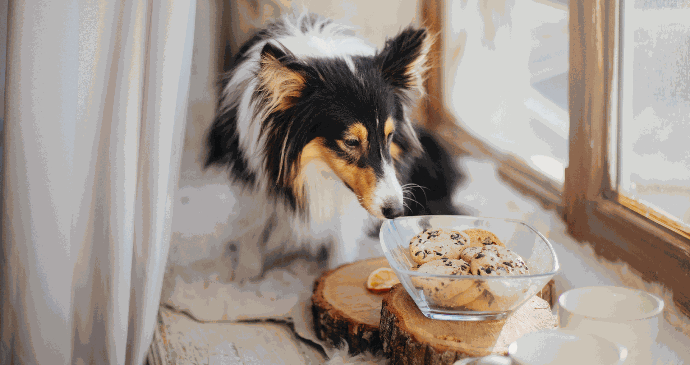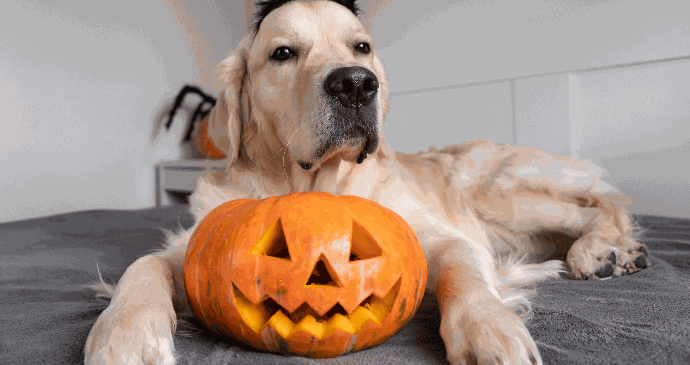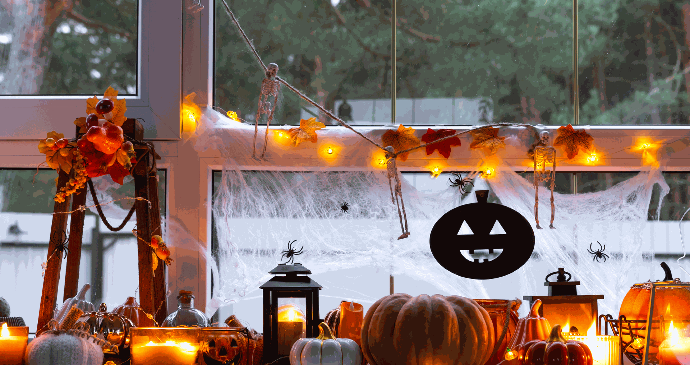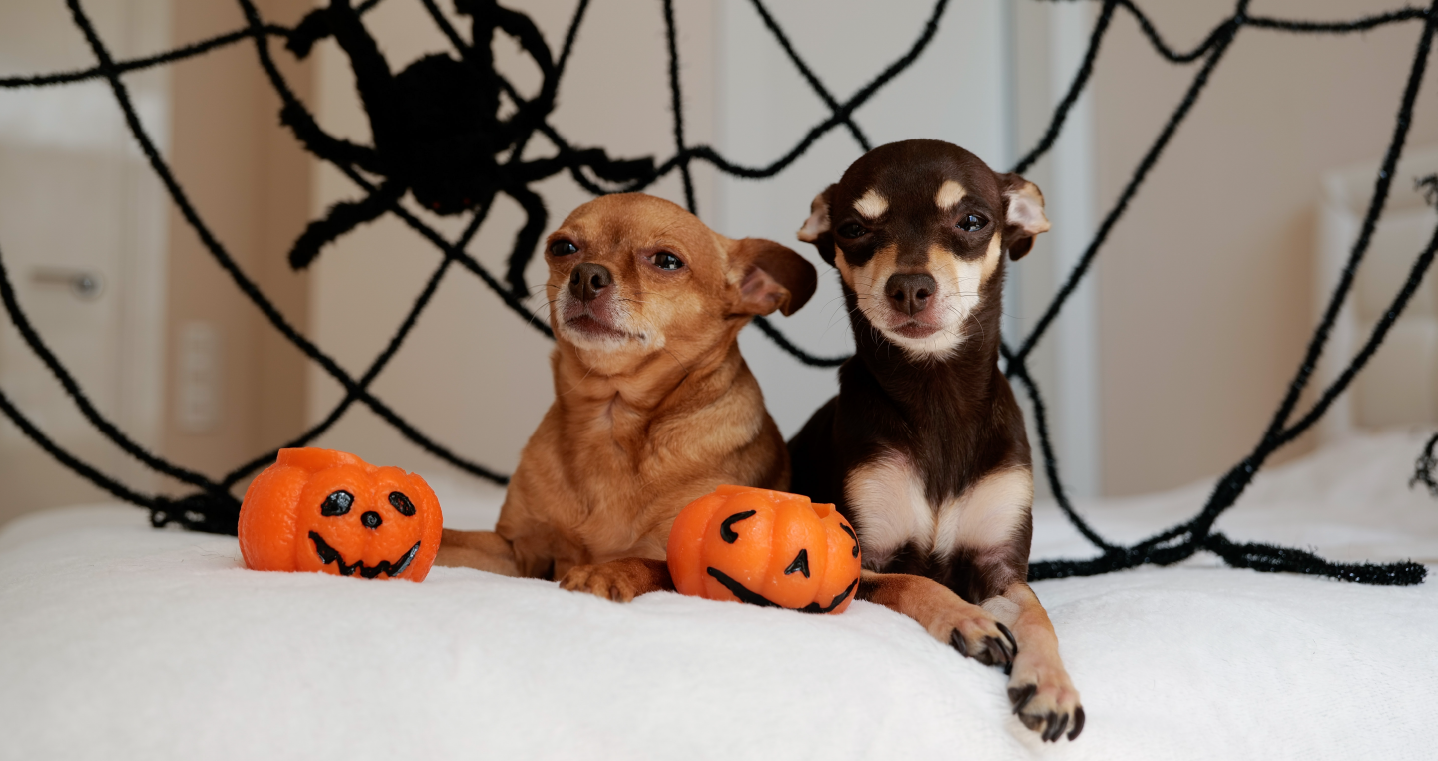The Halloween pet hazards you see year in, year out
Who doesn’t love Halloween? It’s a fun time of year, especially for families, but you know that it brings increased risks for pets. As veterinary professionals, you play a crucial role in ensuring pet owners are well-prepared for any holiday season. During Halloween, everything from toxic treats to dangerous decorations and hidden hazards can lead to a significant rise in emergency visits. By educating your clients on how to keep their pets safe, you help reduce the risk of accidents and promote a happy, hazard-free Halloween for pets and their families.
The common Halloween hazards pet parents don’t always think about
During Halloween, emergency visits to veterinary clinics spike due to the many hazards that pets are exposed to. According to the Pet Poison Helpline, calls regarding pet poisoning increase by approximately 12% during Halloween week*, making it one of the busiest times of the year for pet emergencies. By addressing these common hazards with your community, veterinary professionals preempt these incidents, keep pets safe, and build better connections with the families under your care. Below are some of the most common hazards pets face during Halloween and easy reminders you can share with your families.
*all info below is courtesy of the ASPCA.

Chocolate toxicity
It isn’t Halloween if there’s no chocolate. But chocolate is one of the most well-known Halloween dangers for pets, particularly dogs. Dark chocolate and baking chocolate contain high levels of theobromine and caffeine, which can lead to symptoms like vomiting, diarrhea, hyperactivity, seizures, and even death. Milk and white chocolate are less toxic but can still be harmful if consumed in large amounts (and we all know pups aren’t the model for self control around tasty treats). Remind pet owners to keep all forms of chocolate well out of reach and to educate children on the dangers of sharing their candy with pets.

Xylitol and sugar-free candies
Xylitol, a sugar substitute found in sugar-free candies, gum, and baked goods, is highly toxic to dogs. Even a small amount can cause a rapid drop in blood sugar, leading to weakness, vomiting, seizures, and potentially liver failure. Educate clients about the dangers of xylitol and encourage them to check labels carefully, especially during Halloween when sugar-free treats are more common.

Raw pumpkin and holiday foods
While cooked pumpkin can be a healthy treat for pets, raw pumpkin is harder to digest and may cause gastrointestinal upset. Additionally, many holiday foods contain ingredients that are toxic to pets, such as onions, garlic, and raisins. Remind pet owners to be cautious about what they feed their pets and to avoid giving them raw or seasoned holiday foods.

Toxic flowers, plants and berries
Popular fall decorations like chrysanthemums, holly, and certain ornamental berries can be toxic to pets if ingested. Symptoms can range from mild gastrointestinal upset to more severe reactions like vomiting, diarrhea, and skin irritation. Encourage pet owners to choose pet-safe decorations and to keep potentially toxic plants out of reach.
You can refer your families to this list of toxic plants from the ASPCA, which they can filter by the type of pets in their house.

Glow sticks and Halloween accessories
Glow sticks are everywhere during Halloween. Lots of pet owners walk their dogs around the neighborhood on Halloween night with glow sticks around their collars to stay visible. But the chemicals inside can be harmful if a pet chews on or ingests them. While the liquid is usually not highly toxic, it can cause drooling, nausea, and irritation. Additionally, small accessories or costume pieces can pose a choking hazard.

Other decorations and candles
Halloween decorations like string lights, electrical cords, and candles can pose significant risks to pets. Chewing on cords can lead to electrical burns or shocks, while open flames from candles can cause burns or even start a fire if knocked over. Remind clients to keep candles out of reach (which can be an impossible task for cat owners with acrobatic felines), or consider using flameless candles as a safer alternative
Cute costumes can be hazardous to pets too
Dressing pets in costumes can be a fun way for owners to include their furry friends in the festivities, but it also comes with risks. Tight, too-small costumes can impair a pet’s movement, breathing, or vision, leading to discomfort or even injury. Additionally, costumes with small parts pose choking hazards. Sometimes it’s just an easy reminder to your families that will keep their pets safe.
Keep an eye
Encourage pet owners to supervise their pets while they are wearing costumes. If the pet shows signs of distress - excessive scratching, reluctance to move, or agitation - the costume might not be in the cards.
Test the fit!
Advise pet owners to select costumes that fit comfortably without restricting movement, breathing or vision. They should avoid anything tat could become tight or cause overheating.
Keep it simple
Suggest that owners opt for simple accessories, such as a festive bandana, instead of a full costume. As you know, not all pets want to be dressed up. They’re living creatures, not toys!
Remove the small parts
Pets don’t need intricately detailed costumes. They just look cute in a hat or jacket. Warn clients to steer clear of costumes that have small, detachable parts.
By providing this guidance, veterinary professionals can help pet owners make informed decisions about pet costumes and prevent potential risks, ensuring a safe and enjoyable Halloween for both pets and their families.
Halloween is a weird, confusing time for pets
Halloween can be a very stressful time for pets. Constant noise, strange visitors, and unusual disruptions to their normal routine make them uncomfortable. The ASPCA recommends these 5 strategies to pet owners. Your families probably don’t visit the ASPCA website for any reason, so you can help share the advice.
1. Encourage pet owners to designate a quiet, comfortable space in their home where their pet can feel safe. This space should be away from the front door and contain familiar items such as their bed, favorite toys, and water.
2. Suggest using calming aids such as pheromone diffusers, anxiety wraps, or natural supplements that are known to help alleviate stress in pets. This is a good opportunity to upsell products you carry in the clinic, but also to help families feel cared for.
3. To reduce the risk of escape and anxiety, advise pet owners to keep their pets in a secure area away from the front door during peak trick-or-treating hours. This prevents pets from bolting outside due to fear or excitement (and protects trick-or-treaters who aren’t comfortable with pets).
4. Encourage pet owners to give their pets plenty of exercise earlier in the day. Physical activity can help tire pets out, reducing anxiety and making them more relaxed during the evening festivities.
5. If a pet is particularly fearful, suggest limiting exposure to people in costumes. Masks, hats, and strange clothing can be very frightening to pets, so it’s best to keep interactions to a minimum.
3. To reduce the risk of escape and anxiety, advise pet owners to keep their pets in a secure area away from the front door during peak trick-or-treating hours. This prevents pets from bolting outside due to fear or excitement (and protects trick-or-treaters who aren’t comfortable with pets).
4. Encourage pet owners to give their pets plenty of exercise earlier in the day. Physical activity can help tire pets out, reducing anxiety and making them more relaxed during the evening festivities.
5. If a pet is particularly fearful, suggest limiting exposure to people in costumes. Masks, hats, and strange clothing can be very frightening to pets, so it’s best to keep interactions to a minimum.
Pet-safe Halloween moves
To help pet owners keep their pets safe while still enjoying the Halloween festivities, consider recommending some pet-safe alternatives.
Pet owners can bring home Halloween-themed pet-safe treats. You or your affiliated pet supply store probably have some right at the front desk.
Or they can make homemade treats using simple, pet-safe ingredients! Cooked pumpkin, apples, and peanut butter (xylitol-free), or whatever else you recommend. This can be a fun activity that helps with family (pet included) bonding.
If their pets enjoy being dressed up, recommend pet owners opt for lightweight, simple costumes or accessories like bandanas.
And if they don’t need to be at the front door serving candy, there’s nothing wrong with curling up on the couch to watch Beetlejuice, The Adams Family, or Hocus Pocus (classics!).
A fun and safe Halloween for pets

Halloween is fun for kids (and kids at heart), but families sometimes forget that pets don’t understand the holiday like we do.
As veterinary professionals, you have an opportunity to help pet owners strike the right balance. Keeping pets safe while still allowing them to be part of the festivities.
By providing guidance on common hazards, costume safety, stress reduction, and pet-safe alternatives, you can equip pet owners with the tools they need for a happy, healthy Halloween. You also show the families at your clinic that you think about the wellbeing of their furry family members outside the confines of the clinic, and build a better relationship in the process.
And if you want to build a better relationship with pet families inside your clinic walls, consider adding a few veterinary fluid warmers to your practice. The iVETMate IV fluid warmer improves outcomes for pets in your care, and that leads to more referrals and even better growth for your practice.
Sources:
Pet Poison Helpline | Halloween Dangers to Dogs and Cats
The ASPCA | People Foods to Avoid Feeding Your Pets
FDA | Paws Off! Xylitol is Toxic to Dogs
The ASPCA | Toxic and Non-Toxic Plants List